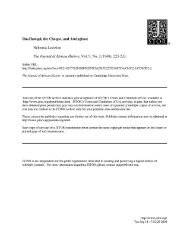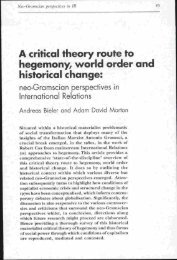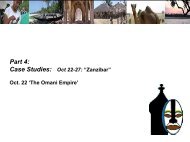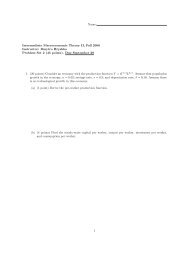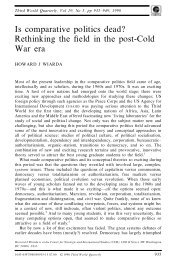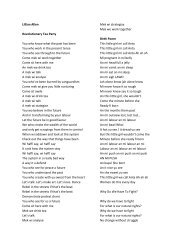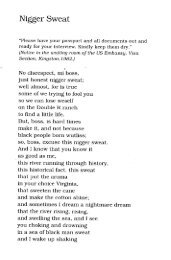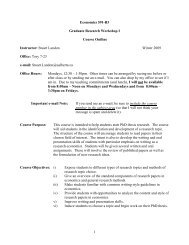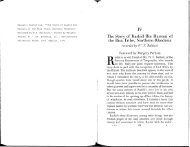personal memories revolutionary states and indian ocean migrations
personal memories revolutionary states and indian ocean migrations
personal memories revolutionary states and indian ocean migrations
You also want an ePaper? Increase the reach of your titles
YUMPU automatically turns print PDFs into web optimized ePapers that Google loves.
Sulayman corrected the slave. He was not a shaykh, he said, but a servant<br />
of shaykhs. With that, as the story is told, the wedding was called off. 11 Sulayman<br />
bin Sleyum was a baysar, 12 <strong>and</strong> thus, to Omanis <strong>and</strong> their trusted slaves, unfit for<br />
marriage to an Omani of noble birth.<br />
This failed attempt at marriage between two people of Omani descent in<br />
the town of Tabora, several hundred miles from Zanzibar <strong>and</strong> several thous<strong>and</strong><br />
miles from Oman, hinged on notions of status imported from Oman. This raises<br />
important questions. Who were the people who identified others as baysar, <strong>and</strong><br />
who were identified that way? 13 In nineteenth <strong>and</strong> early twentieth century East<br />
Africa, Omanis became part of increasingly multi-ethnic societies in Zanzibar <strong>and</strong><br />
the East African interior, yet it is clear in a number of examples that this societal<br />
differentiation from Oman continued to operate. At the same time, however, new<br />
opportunities for mobility, wealth, <strong>and</strong> marriage in new communities offered people<br />
identified as baysar new contexts in which to escape social limitations imposed by<br />
other Omanis. The tension here is between the kind of constructed <strong>and</strong> fluid<br />
identities that could occur in frontier places <strong>and</strong> the kind of identifications <strong>and</strong><br />
fixed social statuses within established communities. A review of historical accounts<br />
<strong>and</strong> usage of baysar helps illuminate its meanings, but it is only in a certain social<br />
milieu that one can see the results of the status in practice.<br />
In popular conceptions today, people of Arab descent in East Africa <strong>and</strong><br />
Oman identify baysar as those without a tribe <strong>and</strong> who may or may not be Arabs. 14<br />
This set of labels exists for those with a claim on Arabness; those who do not claim<br />
Arab descent were unfamiliar with the status of baysar. Perhaps their predecessors<br />
in East Africa may have known of this str<strong>and</strong> of Arab identity—certainly the slave<br />
in the story of the failed wedding did—but, “baysar” is not included in early Swahili<br />
dictionaries. 15 The contemporary lack of knowledge of this category today may be<br />
attributed to a compression of all categories of Arab <strong>and</strong> Arab descended people in<br />
eastern Africa over the last century.<br />
The term baysar, as it is used in East Africa, derives from the Omani<br />
Arabic word baysarī (plural bayāsira). Written sources give a variety of meanings, all<br />
of which connote low status <strong>and</strong> suggest the lack of origin. 16 Serjeant equates it<br />
with the da’īf (ﻒﻴﻌﺿ)[weak] class in southern Arabia, <strong>and</strong> there maybe a historical<br />
link to both the concept <strong>and</strong> the region. 17 Some consider baysar to be a different<br />
race than Arabs, <strong>and</strong> thus mawāli. 18 The concept of baysarness has circulated in<br />
Arabia beyond Oman including Kuwait, Bahrain, <strong>and</strong> the United Arab Emirates. 19<br />
With Arabian migrants, the status traveled to East Africa. After considering the<br />
literature on baysar <strong>and</strong> treatment of the various Arab identities in East Africa, we<br />
will return to the topic of baysar in Oman <strong>and</strong> East Africa to explore the limited<br />
references to this status from the nineteenth century.<br />
To date the most sustained writing on baysar status <strong>and</strong> identity in Oman is<br />
J.C. Wilkinison’s 1974 article comparing bayāsira <strong>and</strong> bayādīr. He identifies the<br />
former as perhaps the earliest inhabitants of eastern <strong>and</strong> southern Arabia, a group<br />
without origin ( ﻞﺻا ) who were never assimilated into the dominant Arabic social<br />
order after the rise of Islam. 20 Bayādīr, on the other h<strong>and</strong>, operates as a social class<br />
linked to agricultural work that has been incorporated into tribal structures in the<br />
Ibadi areas of Oman, but not in the Sunni regions, where the status remains marked<br />
as low. 21 Here Wilkinson is interested in “the underlying layers in the palimpsest of<br />
present traditional social organization in South East Arabia.” Wilkinson argues that<br />
the explanation of bayāsira that rest on a deep history of Arabia <strong>and</strong> Islamic<br />
conversion is one that works socially, but not historically. He over<strong>states</strong> his case,<br />
Vol. 5, Fall 2005, © 2005 The MIT Electronic Journal of Middle East Studies<br />
36



